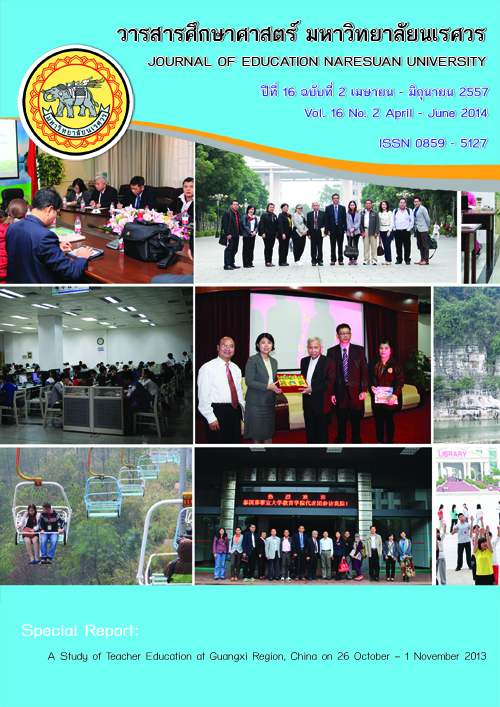การพัฒนาหลักสูตรท้องถิ่นเรื่องพะยูนและหญ้าทะเล สำหรับโรงเรียนชายฝั่งจังหวัดตรัง
Main Article Content
Abstract
บทคัดย่อ
การพัฒนาหลักสูตรท้องถิ่นเรื่องพะยูนและหญ้าทะเลใช้ทฤษฎีเชิงระบบ ประกอบด้วย 1) ปัจจัยนำเข้า (Input) คือ องค์ความรู้เรื่องพะยูนและหญ้าทะเลที่ผสมผสานความรู้ภูมิปัญญาชาวบ้านกับความรู้ทางวิชาการ 2) กระบวนการ (Process) คือ ขั้นตอนการพัฒนาหลักสูตรท้องถิ่นมี 5 ขั้นตอน คือ การสร้างหลักสูตรท้องถิ่น การตรวจสอบหลักสูตรท้องถิ่น การทดลองใช้และนิเทศติดตาม การประเมินหลักสูตรท้องถิ่น และการปรับปรุงแก้ไขหลักสูตรท้องถิ่น 3) ผลผลิต (Output) คือ หลักสูตรท้องถิ่น และครู 4) ผลลัพธ์ (Outcome) คือ นักเรียน ผลการศึกษานำเสนอใน 2 ด้าน ดังนี้ ด้านผลผลิต มี 3 ประเด็น คือ 1) ได้หลักสูตรท้องถิ่นเรื่องพะยูนและหญ้าทะเลที่มีคุณภาพ 2) ความรู้ของครูหลังเข้าร่วมพัฒนาหลักสูตรท้องถิ่น สูงกว่าก่อนเข้าร่วมพัฒนาหลักสูตรท้องถิ่น 3) ครูมีความพึงพอใจต่อหลักสูตรท้องถิ่นเรื่องพะยูนและหญ้าทะเลอยู่ในระดับมาก ส่วนด้านผลลัพธ์ มี 2 ประเด็น คือ 1) ผลสัมฤทธิ์ทางการเรียนในรายวิชาวิทยาศาสตร์เรื่องพะยูนและหญ้าทะเลของนักเรียนชั้นประถมศึกษาปีที่ 1, 2, 4, 6 (ค่าเฉลี่ย 9.52, 8.31, 8.14, 8.61 ตามลำดับ) และมัธยมศึกษาปีที่ 2 (ค่าเฉลี่ย 7.95) สูงกว่าเกณฑ์ร้อยละ 70 ของคะแนนเต็ม (p=0.000, 0.000, 0.000, 0.000, 0.000 ตามลำดับ) ส่วนผลสัมฤทธิ์ทางการเรียนของนักเรียนชั้นประถมศึกษาปีที่ 3, 5 (ค่าเฉลี่ย 7.06, 7.25 ตามลำดับ) และชั้นมัธยมศึกษาปีที่ 1, 3 (ค่าเฉลี่ย 7.12, 7.38 ตามลำดับ) ไม่แตกต่างจากเกณฑ์ (p=0.848, 0.204, 0.588, 0.270 ตามลำดับ) 2) นักเรียนมีความพึงพอใจต่อหลักสูตรท้องถิ่นเรื่องพะยูนและหญ้าทะเลทะเลในระดับมาก
คำสำคัญ: การพัฒนาหลักสูตรท้องถิ่น/ พะยูนและหญ้าทะเล/ โรงเรียนชายฝั่ง
Abstract
Development of local curriculum regarding dugong and seagrass was based on system theory which composed of 4 main components: 1) input was dugong and seagrass knowledge which mixed between indigenous and academic knowledge; 2) process was five steps in local curriculum development: creating, verifying, trying out and monitoring, evaluating, and improving local curriculum; 3) outputs were local curriculum and teachers; and 4) outcome was student. Two main results of this study were as follows. In terms of output, there were 3 main findings: 1) local curriculum about dugong and seagrass had good quality; 2) teachers’ knowledge about dugong and seagrass in posttest was higher than the pretest from participation in local curriculum development; and 3) teachers’ satisfaction towards local curriculum about dugong and seagrass was in high level. In terms of outcome, there were 2 main findings: 1) learning achievement in science subject regarding dugong and seagrass of primary students in class 1, 2, 4, 6 (mean 9.52, 8.31, 8.14, 8.61, respectively) (p=0.000, 0.000, 0.000, 0.000, 0.000, respectively) and secondary students in class 2 (mean 7.95) was higher than 70% of total scores, moreover, learning achievement of primary students in class 3, 5 (mean 7.06, 7.25, respectively) and secondary students in class 1, 3 (mean 7.12, 7.38, respectively) was not different from criteria (p=0.848, 0.204, 0.588, 0.270, respectively), and 2) students’ satisfaction towards local curriculum about dugong and seagrass was in high level.
Key words: Local curriculum development/ Dugong and seagrass/ Coastal schoolArticle Details
The owner of the article does not copy or violate any of its copyright. If any copyright infringement occurs or prosecution, in any case, the Editorial Board is not involved in all the rights to the owner of the article to be performed.


